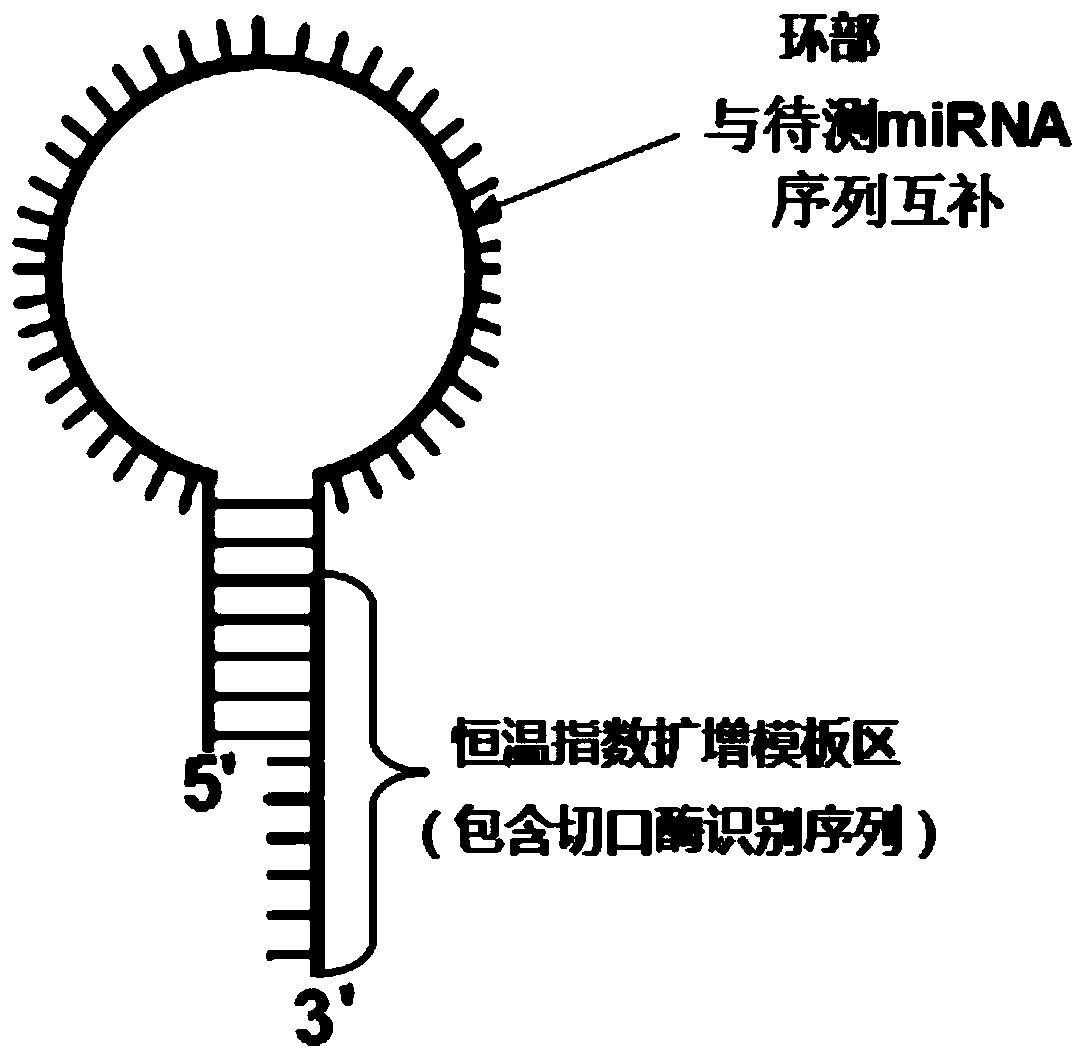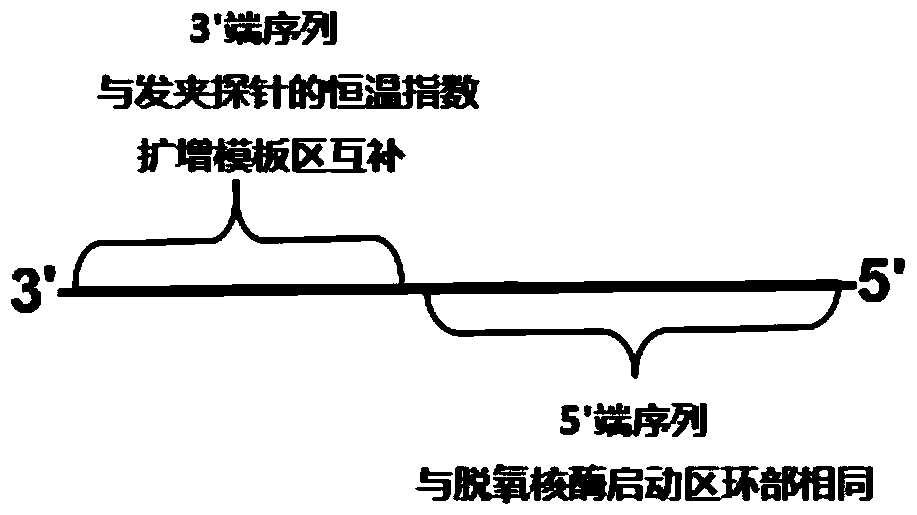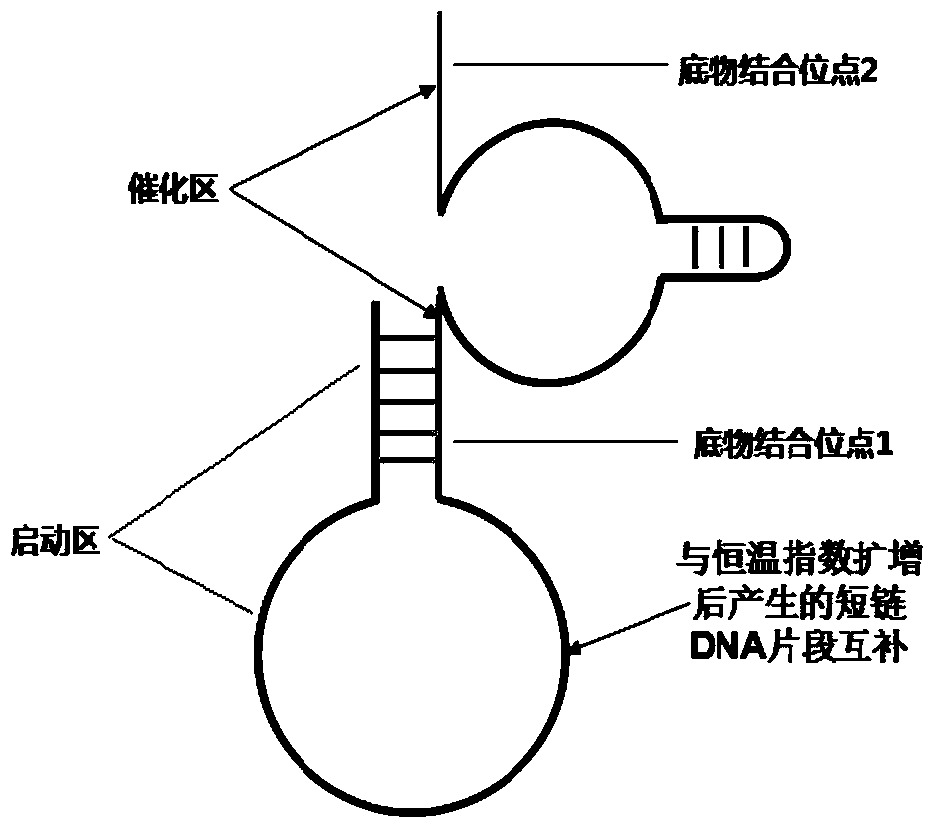A constant temperature exponential amplification technique based on triple amplification reaction cascade and its application in microRNA detection
A technology of constant temperature index and constant temperature index amplification, which is used in the determination/inspection of microorganisms, biochemical equipment and methods, etc., can solve the problems of high false positive rate, high detection background signal, complex primer design, etc., to reduce the system Effectiveness of background signal, improving assay specificity, avoiding false positive test results
- Summary
- Abstract
- Description
- Claims
- Application Information
AI Technical Summary
Problems solved by technology
Method used
Image
Examples
Embodiment 1
[0059] Example 1 The composition of the constant temperature exponential amplification kit based on triple amplification reaction series for detecting miR-27a:
[0060] (1) Hairpin probe:
[0061] 5' End Neck Ring 3' End Neck
[0062] 5'-TTGACTC--GCGGAACTTAGCCACTGTGAA-- GAGTCAA--AT -3' (SEQ ID NO.1)
[0063] Thermostatic exponential amplification of template regions
[0064] The hairpin probe includes a 5' end neck, a loop, and a 3' end neck, and the 3' end neck extends at least 2nt to form an amplification fulcrum; the 3' end neck and the amplification fulcrum form a constant temperature exponential amplification template region, the The stretch sequence is likewise a nickase recognition sequence.
[0065] (2) Constant temperature exponential amplification primers:
[0066] 5'-TTGTTATCACCTATG -- ATT TGACTC-3' (SEQ ID NO.2)
[0067] 5' end sequence 3' end sequence
[0068] The constant temperature index amplification primer includes a 5' end sequence and a 3' end s...
Embodiment 2
[0082] Example 2 Establishment and specificity verification of a constant temperature exponential amplification detection method based on triple amplification reaction series for miR-27a
[0083] Prepare three reaction solutions A, B, and C on ice:
[0084] A reaction solution: 0.1 μM hairpin probe, 250 μM dNTP, 40 nM constant temperature exponential amplification primer, 0.8 U μL -1 RNase inhibitor and DEPC-treated water to a total volume of 10 µL.
[0085] B reaction solution: miRNA to be tested, 0.5×Nt.BstNBI buffer, 1×ThermoPol buffer, 0.4U·μL - 1 Nt.BstNBI nickase, 0.32U·μL -1 Bst DNA polymerase and DEPC-treated water to a total volume of 15 µL.
[0086] C reaction solution: 2mM Mg 2+ , 2 μM DNase substrate, 1 μM DNase and DEPC-treated water in a total volume of 5 μL.
[0087] Solution A was first incubated at 95°C for 5 minutes to denature the hairpin probes and bound primers, and then cooled to 55°C. Add solution B and mix, incubate at 55°C for 60 minutes and the...
Embodiment 3
[0090] Example 3 Optimization of the Constant Temperature Exponential Amplification Detection Method Based on Triple Amplification Reaction Series
[0091] The amplification efficiency of this method is affected by factors such as magnesium ions, incubation time and temperature, and the concentration of the working buffer. By optimizing, such as Figure 6 As shown, the best experimental conditions are obtained: Mg 2+ The concentration is 2mM; the incubation time is 60min; the incubation temperature is 55°C; the buffer system is ThermoPol buffer:Nt.BstNBI buffer=1:1.
PUM
 Login to View More
Login to View More Abstract
Description
Claims
Application Information
 Login to View More
Login to View More - R&D
- Intellectual Property
- Life Sciences
- Materials
- Tech Scout
- Unparalleled Data Quality
- Higher Quality Content
- 60% Fewer Hallucinations
Browse by: Latest US Patents, China's latest patents, Technical Efficacy Thesaurus, Application Domain, Technology Topic, Popular Technical Reports.
© 2025 PatSnap. All rights reserved.Legal|Privacy policy|Modern Slavery Act Transparency Statement|Sitemap|About US| Contact US: help@patsnap.com



